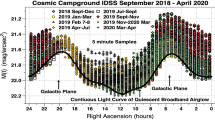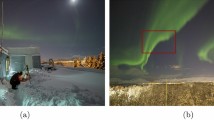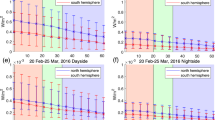Abstract
I HAD a fine view of this superb display at Workington between midnight and 1 o'clock a.m., in a clear and bright starlit sky. The whole sky was filled with the light except a small area in the south-east. I could detect no colour except creamy-white, the general intensity being, to my mind, at times equal to full moonlight. Curtains of light surrounded a point just east of the zenith, which seemed to mark the “hub” of the display. The bright star (a) in Canes Venatici almost exactly marked this point, and filmy sheets of light seemed to dash upwards from the south-west and north-east horizons and merge together at this star. The only display I have ever seen to equal this was on 1907 February 14 at Motherwell, in the previous sun-spot maximum period. It was the fact that I could see the great sun-spot train on March 22 without telescopic aid that made me expect and look out for the aurora that night.
This is a preview of subscription content, access via your institution
Access options
Subscribe to this journal
Receive 51 print issues and online access
$199.00 per year
only $3.90 per issue
Buy this article
- Purchase on SpringerLink
- Instant access to full article PDF
Prices may be subject to local taxes which are calculated during checkout
Similar content being viewed by others
Author information
Authors and Affiliations
Rights and permissions
About this article
Cite this article
HOUSMAN, W. The Aurora of March 22–23. Nature 105, 200 (1920). https://doi.org/10.1038/105200c0
Issue date:
DOI: https://doi.org/10.1038/105200c0



